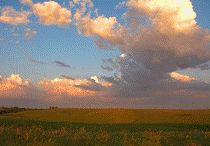
Proceedings of the North American Prairie Conferences
Date of this Version
2004
Document Type
Article
Abstract
Several grassland bird species have been shown to be area sensitive. This area sensitivity occurs when a species' frequency of occurrence, or relative abundance, tends to be lower in smaller fields. The detection of area sensitivity, however, is not consistent among studies because a species may exhibit area sensitivity in one study, but not in another. We tested the hypothesis that a species' area sensitivity varies depending on the amount of grassland in the landscape. The study took place in central North Dakota during the 1996 and 1997 breeding seasons on 46 fields enrolled in the Conservation Reserve Program (CRP). One species, the bobolink (Dolichonyx oryzivorus), displayed variable area~sensitivity consistent with our predictions. In landscapes with greater amounts of grassland, the species' relative abundance in smaller fields was higher. Thus, the species' area sensitivity decreased in landscapes with greater amounts of nesting habitat. This finding suggests that use of small prairie remnants by area~sensitive species may be enhanced by increasing the amount of grassland in the surrounding landscape.


Comments
Published in Dave Egan & John A. Harrington, editors, Proceedings of the 19th North American Prairie Conference: The Conservation Legacy Lives On..., University of Wisconsin-Madison, August 8-12, 2004 (Proceedings of the North American Prairie Conference, 19), Madison, WI: University of Wisconsin-Madison, 2004.